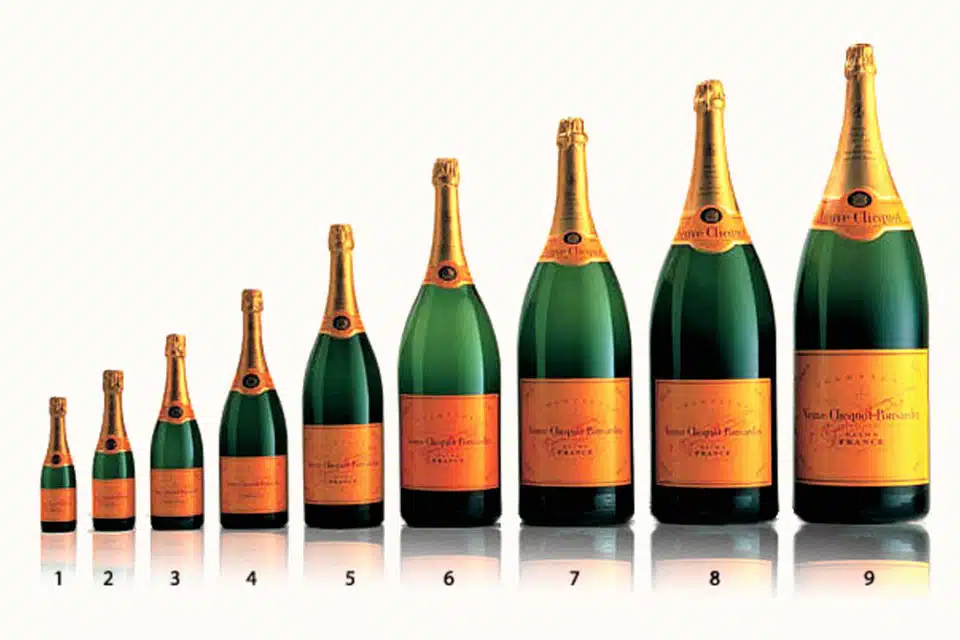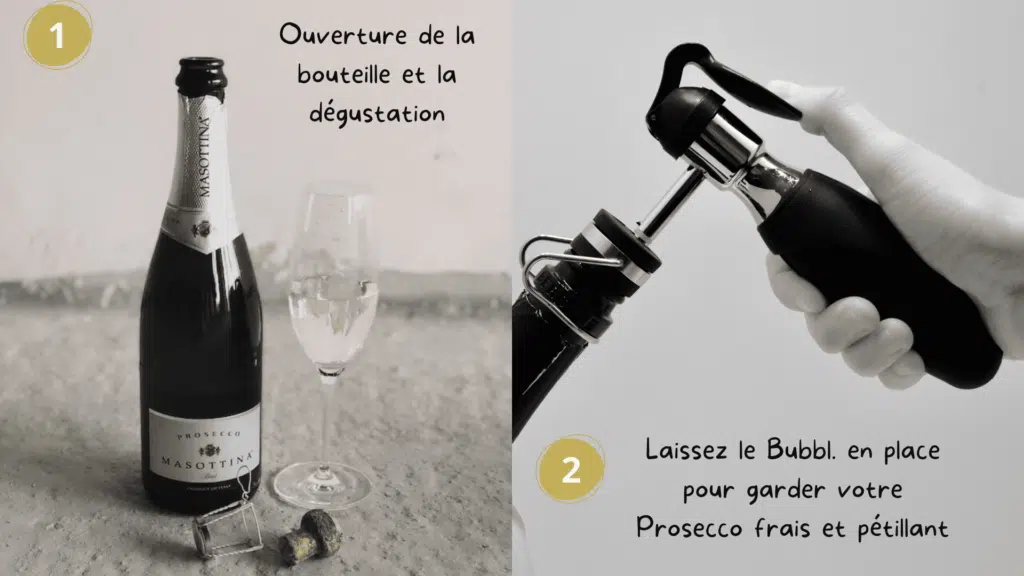Getting to know champagne bottle sizes helps you pick the perfect format for any occasion, from an intimate toast to a grand celebration. This guide covers every champagne bottle format, from the small 20 cl piccolo to the massive 15 L nebuchadnezzar, complete with volume details, glass counts, purchasing advice, and helpful tips.
Champagne bottle sizes explained
The champagne world follows an established system of bottle formats, each with a traditional name and precise volume. Whether you’re reaching for a quarter bottle or a show-stopping large format, every size—including the 75 cl standard champagne bottle—has its place in serving sparkling wine.

What glass counts to expect
Champagne bottle sizes follow a logical progression based on the standard 75 cl bottle, making it simple to calculate servings. Using standard 125 ml champagne flutes, here’s what you can expect from each size:
- Piccolo/Quarter (0.187-0.20 L) : Perfect for solo enjoyment, this size fills 1-2 flutes—ideal for minibars or wine tastings.
- Demi/Half (0.375 L) : Offers about 3 flutes of champagne, making it great for couples or small gatherings.
- Standard (0.75 L) : The universal champagne bottle size containing six flute servings—the baseline for all other formats.
- Magnum (1.5 L) : Double the standard bottle, providing twelve flutes and favored by collectors for aging potential.
- Jeroboam (3 L) : Four standard bottles in one, pouring twenty-four flutes—excellent for medium-sized parties.
- Methuselah (6 L) : The equivalent of eight standard bottles (forty-eight flutes), often chosen for weddings.
- Salmanazar (9 L) : Twelve standard bottles’worth, serving seventy-two flutes—typically special order only.
- Balthazar (12 L) : Matches sixteen standard bottles (ninety-six flutes) and usually requires advance planning.
- Nebuchadnezzar (15 L) : The ultimate champagne bottle format, holding twenty standard bottles (120 flutes) for truly grand events.
For larger 150 ml pours, adjust accordingly—a standard bottle yields about 5 glasses instead of 6. When planning, always account for extra servings as people tend to pour generously during celebrations.
| Format Name | Volume | Standard Multiples | Flutes (125ml) |
| Piccolo/Quarter | 0.187-0.20 L | ¼× | 1-2 |
| Demi/Half | 0.375 L | ½× | 3 |
| Standard | 0.75 L | 1× | 6 |
| Magnum | 1.5 L | 2× | 12 |
| Jeroboam | 3 L | 4× | 24 |
| Methuselah | 6 L | 8× | 48 |
| Salmanazar | 9 L | 12× | 72 |
| Balthazar | 12 L | 16× | 96 |
| Nebuchadnezzar | 15 L | 20× | 120 |
Which formats are easiest to buy
Beyond magnums, finding champagne bottles becomes increasingly difficult. The 75 cl standard champagne bottle and 1.5 L magnum are widely available at most wine retailers, making them the practical choice for everyday enjoyment and celebrations.
Jeroboams (3 L) offer a middle ground—many specialty shops stock them or can order from champagne houses within a few days. For larger methuselah bottles (6 L), you’ll typically need to place an advance order, with delivery times of 1-3 weeks.
True giant formats—salmanazar (9 L), balthazar (12 L), and nebuchadnezzar (15 L)—are almost exclusively special-order items, often requiring several weeks or months’notice, especially for specific vintages or customized labels.
Ageing and serving by size
Larger champagne bottle formats offer distinct aging advantages. With more wine volume relative to the headspace, magnums and larger sizes mature more slowly and gracefully than standard bottles. Their greater mass also helps buffer against temperature fluctuations.
However, serving challenges increase with size. A methuselah needs 4-6 hours to chill properly, and the weight becomes significant—a filled nebuchadnezzar approaches 38 kg! Always store champagne on its side at 10-12°C with 70% humidity, then serve at 8-9°C for optimal enjoyment.
Champagne giants from jeroboam up
Beyond the impressive 15-liter Nebuchadnezzar lies an exclusive realm of extraordinary champagne bottle sizes designed for show-stopping moments and record-breaking achievements. These massive formats push the boundaries of glass craftsmanship and winemaking expertise, serving as breathtaking centerpieces that capture attention at high-profile celebrations across the globe.
What’s the biggest bottle you can buy
The most notable large champagne bottle sizes include the Solomon or Melchior (18L/144 flutes), Sovereign (26.25L/210 glasses), Primat or Goliath (27L/216 pours), and the colossal Melchizedek (30L/240 flutes). Even prestigious champagne houses produce these in extremely limited quantities, reserving them primarily for marketing events, luxury auctions, or world record attempts.
With no official standards governing sizes above the Nebuchadnezzar, capacities and names may vary slightly between producers. Always confirm exact capacity, packaging specifications, and availability directly with the champagne house. The regal names – inspired by biblical kings and rulers – perfectly reflect the ceremonial prestige these magnificent vessels command in elite wine circles.
Logistics, cost and safety tips
Purchasing a jeroboam or larger format involves far more than just selecting a wine. A full Nebuchadnezzar tips the scales at about 38kg, while a Melchizedek can reach 50kg and nearly one meter in height – often requiring specialized equipment for handling and transportation.
- Venue preparation : Ensure adequate refrigeration space, proper door access, and a secure display area. You may need custom cooling solutions like oversized ice baths or troughs.
- Service strategy : Let the giant bottle shine during photos and ceremonial moments, but serve most guests from standard 75cl bottles for efficiency and safety.
- Ordering timeline : Plan ahead – reserve any bottle 9L or larger several months in advance due to limited production windows and specific bottling schedules.
- Cost structure : Prices increase dramatically for these special formats due to custom glassware, transportation challenges, limited availability, and premium positioning.
Safety becomes paramount when dealing with bottles larger than magnum size. While sabering regular bottles is manageable and magnums somewhat challenging, attempting this on extreme sizes can be dangerous. For anything over 6L, always use a pouring cradle, ensure at least two handlers, and position securely to prevent tipping in crowded settings.
Choosing champagne sizes for occasions
Selecting the perfect champagne bottle size ensures you have enough wine for your guests while making a visual statement. Consider the number of attendees, how you’ll serve it, menu length, and formality level to pick formats that balance practicality with celebration.
How many bottles for my guest count
When planning your event setup, note that champagne bottle dimensions (cm) grow significantly with larger capacities, affecting how you store and display them. A standard 75cl bottle stands roughly 30 cm tall, while massive Nebuchadnezzars can reach 90 cm. Allow enough space, account for 125ml per flute, and include extra for refills and generous pours.
- Small gatherings (2-6 people): One standard bottle (75cl) or a Demi (half-bottle) for couples prevents waste while providing just enough
- Dinner parties (8-12 guests): A single Magnum works beautifully, or opt for two standard bottles for more flexible serving
- Medium events (20-30 guests): One 3L Jeroboam pours about 24 glasses, or combine Magnums with standard bottles as backup
For weddings or large receptions (100+ guests), a Nebuchadnezzar pours approximately 120 glasses – with additional standard bottles kept chilled to maintain serving temperature, prevent crowding at the bar, and ensure smooth continuous service.
Pro tip: Mix bottle sizes rather than sticking to one format. Display an impressive Magnum or Jeroboam prominently while keeping standard bottles on ice as practical backups, allowing you to adjust to consumption patterns without disrupting the festive mood.
Why pick a magnum for aging
Experienced collectors prefer Magnum champagne bottle sizes when cellaring premium vintages. The 1.5L format’s ideal oxygen-to-wine ratio helps champagne age more gracefully, developing finer bubbles and greater complexity compared to standard bottles.
Research shows Magnums maintain more stable internal temperatures due to their greater thermal mass, which minimizes rapid temperature fluctuations. This stability – combined with a smaller cork surface area – significantly reduces oxidation during long-term storage. Blind tastings consistently reveal that properly aged Magnums outperform standard bottles of the same vintage.
Keep opened bottles fresh all week
Modern preservation systems can maintain opened champagne’s sparkle and aroma for days, whether from a standard bottle or larger format. The professional-grade preservation technology uses specialized caps and inert gas cartridges to re-pressurize the bottle, preventing oxidation while keeping bubbles lively for up to seven days.
Store resealed bottles upright in a fridge below 10°C to maximize freshness. Independent tests confirm properly preserved champagne maintains its quality and visible sparkle for 5-7 days – perfect for extended by-the-glass service while dramatically reducing waste.

